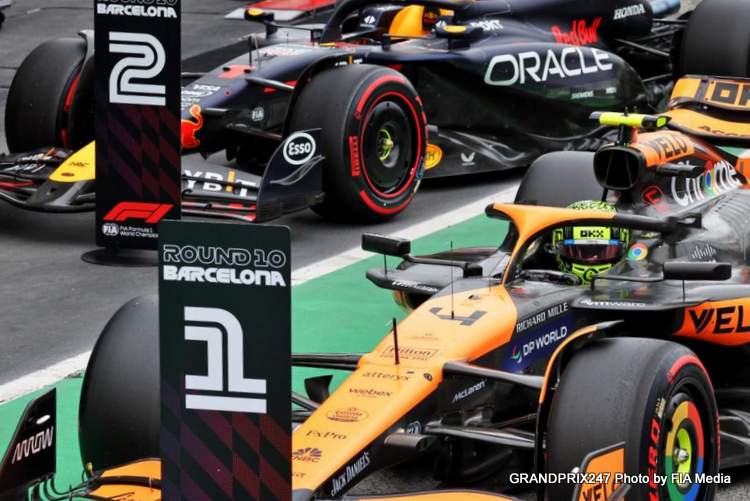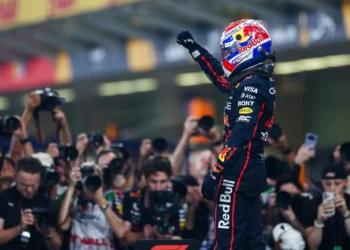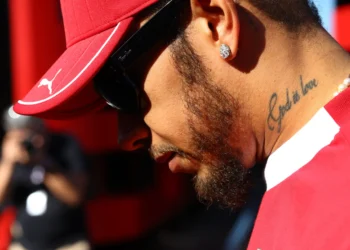Circuit de Barcelona-Catalunya is undoubtedly the most well-known track for Formula 1 teams and drivers. Teams are familiar with it because it used to be a popular testing venue, while drivers have extensively competed there in races and junior series testing sessions.
Therefore, I anticipated that the Barcelona Qualifying, the tenth session of the year, would be particularly intense. Teams push their cars to the limit, and drivers strive to extract maximum performance. The conditions were nearly ideal, except for some crosswinds that affected everyone.
The first qualifying session (Q1) provided the most significant data to analyze. I used a simple mathematical method to determine the order of classification. Lewis Hamilton set the fastest lap time of 1:12.143 in Q1, driving the Mercedes #44. This time became the benchmark, or “absolute zero,” at the top of the standings. Hamilton’s teammate, George Russell, was 0.313 seconds slower than the benchmark. Therefore, the average time for Mercedes in the session was 0.156 seconds faster than the benchmark, putting them at the top of the classification order in the first session.
It is worth noting that in Q1, the average lap times were all within one second, except for Williams, whose drivers were one second off the pace. The difference between Williams and their closest competitors is similar to the deficit between the top four teams.
Based on the Q1 results, the bottom of the classification order was established. Williams was the slowest team, followed by VCARB and Haas, who were very close to Sauber. These teams are considered the bottom-placed ones.
Passing to Qualifying Q2, the last three teams were already determined. More information about the classification order emerged, with Max Verstappen setting the fastest lap time of 1:11.653s, becoming the new benchmark for this session.
Unfortunately, Oscar Piastri did not register a time in Q3, which would have been useful for analyzing the classification order. However, based on his average performance in the previous two sessions, we can assume that his deficit in the final session would have been 0.337 seconds.
The absence of the Aston Martin and Stake F1 Sauber drivers meant that the final session provided data for analysis from five teams. Lando Norris secured pole position with an impressive lap time of 1:11.383s, becoming the new benchmark for the final session.
This is the classification in the third qualifying session:
Unfortunately, McLaren’s result is under review. If Piastri had not made mistakes during qualifying, he could have achieved something remarkable and gotten closer to Norris.
The McLaren car is extremely fast, and when fully optimized for the final attempt in the third qualifying session, along with the flawless lap he delivered when it mattered, it indicates that they are currently the strongest combination.
And what about Red Bull, you may wonder? The Verstappen factor is what sets them apart. On Saturday, the RB20 was only the third fastest car on average when it comes to power and setup to deliver the final attempt for the top ten positions on the grid.
McLaren, Red Bull, Ferrari, and Mercedes are the main contenders, with minimal differences between their cars. Norris and Verstappen made the difference for their respective teams on Saturday.
With two cars advancing to the third qualifying session, Alpine leads the midfield ahead of Aston Martin. The stopwatch clearly shows that Alonso makes up for a poor car, while Stroll is the limiting factor that does not do justice to the team. Perhaps a combination of the two is the most accurate assessment for the team that has been the most disappointing this season.
Williams has the slowest car, trailing a full second behind the fastest. Their situation is not helped by Sargeant, who is no match for Albon and probably will not keep his seat beyond this season for obvious reasons.
In terms of the first qualifying session, the rankings were clear, with the best F1 driver – Verstappen – leading the timing screens, while the last position was occupied by you-know-who. Unfortunately, this has been a common sight in the last two seasons.
© 2024
The world of sports is always on the move and full of surprises. And today is no different. This week, a bombshell news rocked the world of football. The international superstar, Cristiano Ronaldo, announced his retirement from the field. At 39 years old, the player decided to end his career and leave fans in shock.
Ronaldo, who is considered one of the greatest players of all time, had a brilliant career. He won numerous titles and awards over the years, including five Ballon d’Ors. His skill and talent on the field have always been admired by fans and teammates.
However, the player revealed in an exclusive interview that he feels it is the right time to hang up his boots. He stated that he does not want to drag himself on the field and prefers to leave at the peak of his career. Ronaldo also mentioned that he wants to dedicate more time to his family and explore new challenges outside of football.
The news of Cristiano Ronaldo’s retirement left many fans in tears. On social media, supporters expressed their sadness and gratitude for the player. Many reminisced about the incredible moments Ronaldo provided throughout his career and wished him all the best in his new journey.
Despite the sadness, it is important to remember that Cristiano Ronaldo’s legacy in football is undeniable. He inspired a generation of players and showed the world what can be achieved with talent, dedication, and hard work. His name will always be remembered as one of the greatest in the history of the sport.
While fans bid farewell to Ronaldo, the world of football prepares for a new era. With the retirement of an icon, new talents will emerge to fill the void left by him. The sport will continue to evolve and captivate crowds, but the presence of Cristiano Ronaldo will always be remembered and revered.










